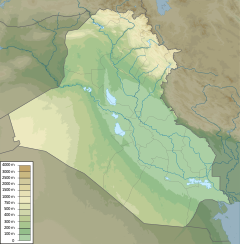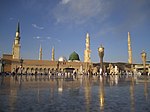
Al-Askari Shrine

| Al-'Askarī Shrine | |
|---|---|
Arabic: مَرْقَد ٱلْإِمَامَيْن عَلِيّ ٱلْهَادِي وَٱلْحَسَن ٱلْعَسْكَرِيّ Marqad al-ʾImāmayn ʿAlī al-Hādī wal-Ḥasan al-ʿAskarī | |
 Al-Askari Mosque in 2021 | |
| Religion | |
| Affiliation | Shia Islam |
| Rite | Shia (Twelver) |
| Ecclesiastical or organisational status | Mosque and shrine |
| Status | Active |
| Location | |
| Location | Samarra, Iraq |
Location in Iraq | |
| Geographic coordinates | 34°11′56″N 43°52′25″E / 34.1989°N 43.8735°E |
| Architecture | |
| Completed | 944 AD |
| Destroyed |
|
| Specifications | |
| Dome(s) | 1 |
| Dome height (outer) | 68 metres (223 ft) |
| Dome dia. (outer) | 20 metres (66 ft) |
| Minaret(s) | 2 |
| Minaret height | 36 metres (118 ft) |
| Spire(s) | 1 (destroyed) |
| Shrine(s) | 3 |
Al-Askari Shrine, the 'Askariyya Shrine, or Al-Askari Mosque[a] is a Shia Muslim mosque and mausoleum in the Iraqi city of Samarra 125 km (78 mi) from Baghdad. It is one of the most important Shia shrines in the world. It was built in 944.[1] The dome was destroyed in a bombing by Sunni extremists in February 2006 and its two remaining minarets were destroyed in another bombing in June 2007, causing widespread anger among Shias and instigation of the Iraqi Civil War between the country's Shia and Sunni factions.[2] The remaining clock tower was also destroyed in July 2007.[3] The dome and minarets were repaired and the mosque reopened in April 2009.[4]

The 10th and 11th Shī'īte Imams, 'Alī al-Hādī ("an-Naqī") and his son Ḥasan al-'Askarī, known as al-'Askariyyayn ("the two 'Askarīs"), are buried in the shrine.[5] Housed in the mosque are also the tombs of Ḥakīma Khātūn, sister of 'Alī al-Hādī; and Narjis Khātūn, the mother of Muḥammad al-Mahdī.[6] Adjacent to the mosque is another domed commemorative building, the Serdab ("cistern"), built over the cistern where the Twelfth Imam, Muḥammad al-Mahdī, first entered the Minor Occultation or "hidden from the view"—whence the other title of the Mahdi, the Hidden Imam.[citation needed]

History
The Imams 'Alī al-Hādī ("an-Naqī") and Haṣan al-'Askarī lived under house arrest in the part of Samarra that had been Caliph al-Mu'tasim's military camp ('Askar al-Mu‘tasim, hence an inmate of the camp was called an 'Askarī). As a result, they are known as the 'Askariyyayn. They died and were buried in their house on Abī Ahmad Street near the mosque built by Mu'tasim.[6] A later tradition attributes their deaths to poison.

Nasir ad-Din Shah Qajar undertook the latest remodelling of the shrine in 1868, with the golden dome added in 1905. Covered in 72,000 gold pieces and surrounded by walls of light blue tiles, the dome was a dominant feature of the Samarra skyline. It was approximately 20 m (66 ft) in diameter by 68 m (223 ft) high.

Bombings
2006 attack
On 22 February 2006, at 6:55 am local time (03:55 UTC) explosions occurred at the shrine, effectively destroying its golden dome and severely damaging the shrine. Several men belonging to Iraqi insurgent groups affiliated with Al-Qaida, one wearing a military uniform, had earlier entered the mosque, tied up the guards there and set explosives, resulting in the blast. Two bombs were set off[7][8] by five[9] to seven[10] men dressed as personnel of the Iraqi Special Forces[11] who entered the shrine during the morning.[12]

Time magazine reported at the time of the 2006 bombing that:

al-Askari [is] one of Shi'ite Islam's holiest sites, exceeded in veneration only by the shrines of Najaf and Karbala. Even Samarra's Sunnis hold al-Askari in high esteem. The expression 'to swear by the shrine' is routinely used by both communities".[13]
2007 attack
At around 8 am on 13 June 2007, operatives belonging to al-Qaeda in Iraq destroyed the two remaining 36-metre-high (118 ft) golden minarets flanking the dome's ruins. No fatalities were reported. Iraqi police reported hearing "two nearly simultaneous explosions coming from inside the mosque compound at around 8 am".[14] A report from state-run Iraqiya Television stated that "local officials said that two mortar rounds were fired at the two minarets".[14]

Reopening
In late 2007, the Iraqi government conducted a contract with a Turkish company to rebuild the shrine. The Iraqi government later cancelled the contract due to delays by the Turkish company.[4] As of April 2009, the golden dome and the minarets have been restored and the shrine reopened to visitors.[4]

Notable burials
- Imam Ali al-Hadi – 10th Imam of Shia
- Imam Hasan al-Askari – 11th Imam of Shia
- Hakima Khatun – Daughter of Shia's 9th Imam
- Narjis – Wife of Shia's 11th Imam
Gallery
-
The Al-Askari Shrine in 1916.
-
The Shrine in 2006 after the first bombing
-
Repairs to the al-Askari Mosque, October 2013
See also
- Bab al-Saghir
- Damage to Baghdad during the Iraq War
- Destruction of early Islamic heritage sites in Saudi Arabia
- Holiest sites in Shia Islam
- Jannat al-Mu'alla
- Jannatul Baqi'
Notes
References
- ^ Knight, Sam (22 February 2006). "Al-Askariya shrine: 'Not just a major cathedral'". The Times. London. Archived from the original on 12 January 2008. Retrieved 23 February 2006.
- ^ "Iraq Timeline: Since the 2003 War". United States Institute of Peace. Retrieved 25 May 2024.
- ^ "Iraqi blast damages Shia shrine". BBC News. 22 February 2006.
- ^ a b c "Iraqis rebuild al-Askari mosque". Al Jazeera.
- ^ "History of the Shrine of Imam Ali al-Naqi & Imam Hasan Al-Askari, Peace Be Upon Them". Al-Islam.org. Archived from the original on 23 February 2006. Retrieved 23 February 2006.
- ^ a b Shrine of Imām al-Hādī and Imām al-‘Askarī Archived 4 March 2006 at the Wayback Machine (ArchNet Digital Library)
- ^ "Explosion destroys Shiite shrine golden dome". Ireland On-Line. Archived from the original on 10 July 2012. Retrieved 23 February 2006.
- ^ "Bombers strike Shia mausoleum in Iraq". IBN Live. Retrieved 23 February 2006.
- ^ Knickmeyer, Ellen (23 February 2006). "Bombing Shatters Mosque in Iraq". The Washington Post. Retrieved 23 February 2006.
- ^ "Blast destroys golden dome of Iraq's shrine". Hindustan Times. Archived from the original on 6 March 2006. Retrieved 23 February 2006.
- ^ Knight, Sam (22 February 2006). "Bombing of Shia shrine sparks wave of retaliation". The Times. London. Archived from the original on 12 January 2008. Retrieved 23 February 2006.
- ^ "Iraqi shrine bombing spurs wave of sectarian reprisals". CBC News. 22 February 2006. Retrieved 23 February 2006.
- ^ "An Eye For an Eye" Archived 14 April 2009 at the Wayback Machine, Time, 26 February 2006.
- ^ a b Graham Bowley (13 June 2007). "Minarets on Shiite Shrine in Iraq Destroyed in Attack". The New York Times.
Further reading
- Hammer, Joshua; Becherer, Max (January 2009). "Samarra Rises". Smithsonian. Vol. 39, no. 10. pp. 28–37. Abstract (characteristic of Smithsonian feature articles): "In 2006, sectarian violence engulfed Iraq after terrorists destroyed the Mosque of the Golden Dome, built on a site sacred to Shiites for 1,100 years. Today, Sunnis and Shiites are working together to restore the shrine and the war-torn city."
- Ellen Knickmeyer and K. I. Ibrahim (23 February 2006). "Bombing Shatters Mosque in Iraq". The Washington Post.
- ICOMOS Heritage at Risk 2006/2007: Iraq, Askariya Shrine
External links
- Ernst Herzfeld Papers, Records of Samarra Expeditions, Shiite Shrine Complex[permanent dead link] Collections Search Center, S.I.R.I.S., Smithsonian Institution, Washington, D.C.
- Ernst Herzfeld Papers, Series 7: Records of Samarra Expeditions, 1906–1945 Freer Gallery of Art and Arthur M. Sackler Gallery Archives, Smithsonian Institution, Washington, D.C.
- Images of the destruction: before and after
- BBC picture gallery
- BBC video
- NYT picture gallery
See what we do next...
OR
By submitting your email or phone number, you're giving mschf permission to send you email and/or recurring marketing texts. Data rates may apply. Text stop to cancel, help for help.
Success: You're subscribed now !







